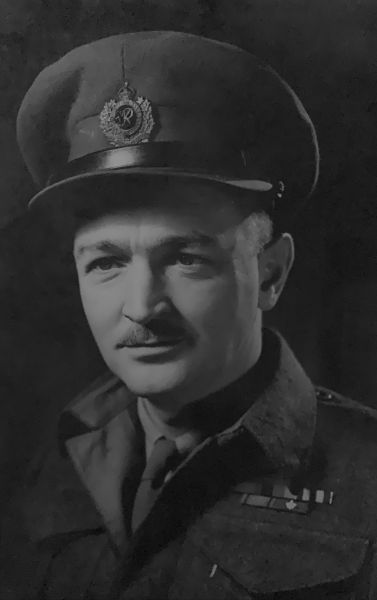McTavish, Frank Alexander
- Date of birth:
- (Ontario, Canada)
- Date of death:
- July 28th, 1967 (North Vancouver/British Columbia, Canada)
- Nationality:
- Canadian
Biography
Promotions:
?: Lieutenant;
May 1940: Major;
?: Lieutenant Colonel.
Career:
?: Company Commander, 2nd Canadian Pioneer Battalion;
?: 1st Battalion, Royal Canadian Engineers;
January 1943: Commanding Officer, 5th Field Company;
?: Commanding Officer, 7th Field Company;
October 1944: Commander Royal Canadian Engineers, (CRE), 3rd Canadian Infantry Division;
?: Officer Commanding Number 6 Works Company / District Engineering Officer, Military District Number 6, Halifax;
?: Command Engineer, Eastern Command;
1948 - 1953: Commander, Royal Canadian School of Military Engineering, Chilliwack;
1954: Army HQ Chief Engineer.
Do you have more information about this person? Inform us!
- Period:
- Second World War (1939-1945)
- Rank:
- Major
- Unit:
- 5th Canadian Field Company, 3rd Canadian Infantry Division, Canadian Army
- Awarded on:
- August 31st, 1944
Major Frank Alexander McTavish, commanding 5 Canadian Field Company, was responsible for clearance of underwater obstacles . He landed with one of his platoons at H-Hour on Nan-Red (Saint-Aubin-sur-Mer). His craft grounded on something, with about ten feet of water at the ramp and under small arms fire from the beach. Determined to get ashore and get started on his task, he arranged for tow ropes from the bulldozers for the personnel to hold on to and also one to tow the 5-cwt truck [jeep]. Lieutenant Stalker volunteered to steer the 5-cwt. He arranged for his driver-operator to ride on top of the bulldozer with his 46 set, to ensure communications. Lieutenant Stalker was killed instantly, and the 5-cwt tow rope parted. Major McTavish and men reached shore and started clearance of obstacles but due to heavy small arms fire and height of water this was impossible. At that time four tanks, hull down at the waters edge, were hit and started to burn. Major McTavish's party suffered heavily while trapped between the exploding tanks and the fire from the enemy positions on shore. His 46 set was lost coming in, so his only means of establishing communications with the platoon next to him was by personal contact. After two unsuccessful attempts he himself managed to scale the low cliff and get round to his next platoon and to the P.B.M. [Principal Beach Master] After consultation with the P.B.M. it was decided where priority work of obstacle clearing would start and Major McTavish organized this, remaining on the job until some 1,800 yards of beach was cleared.
From the time that underwater obstacles were first known to exist on our front, 5 Canadian Field Company was given the task of dealing with them. Major McTavish's keen interest in the work reflected all through the company and the result was that they were at all times quite sure of themselves and their ability to cope with what they might find. The working out of all drills and the calculation and design of the shaped charges used was all done under his supervision and guidance.
Supplement to the London Gazette, 31 August, 1944.



